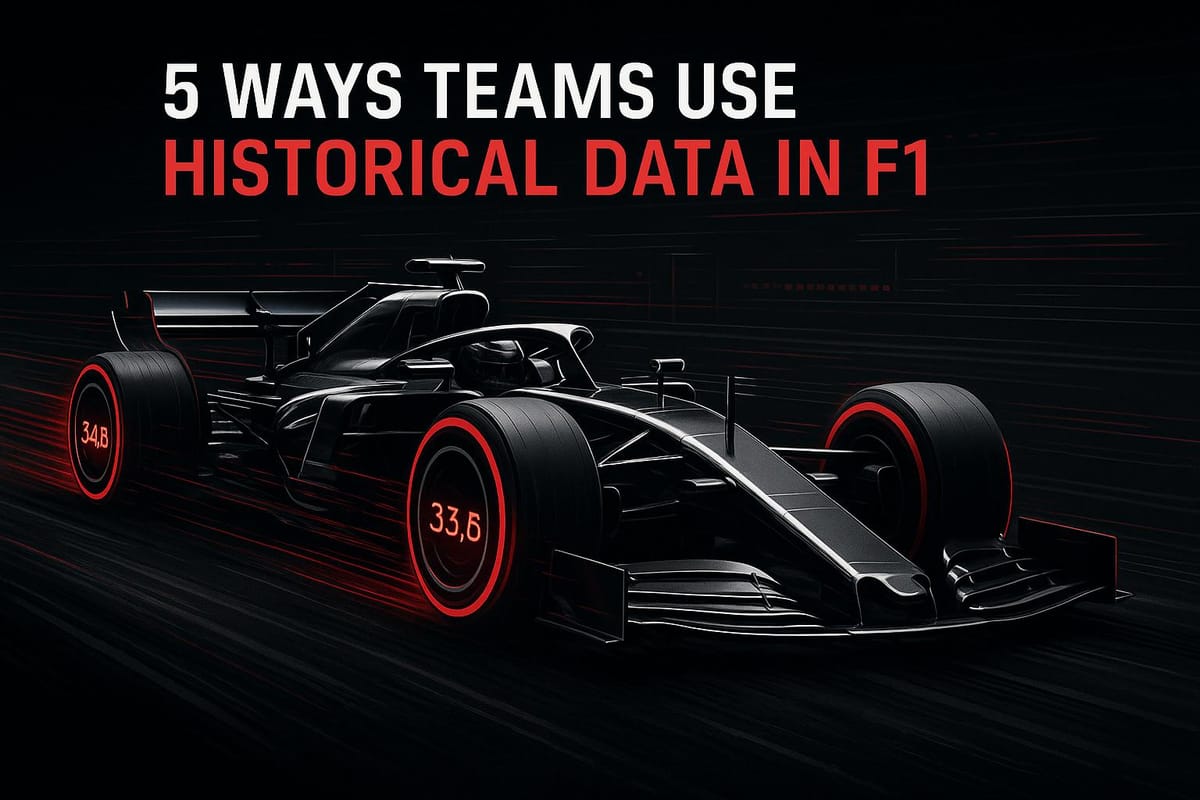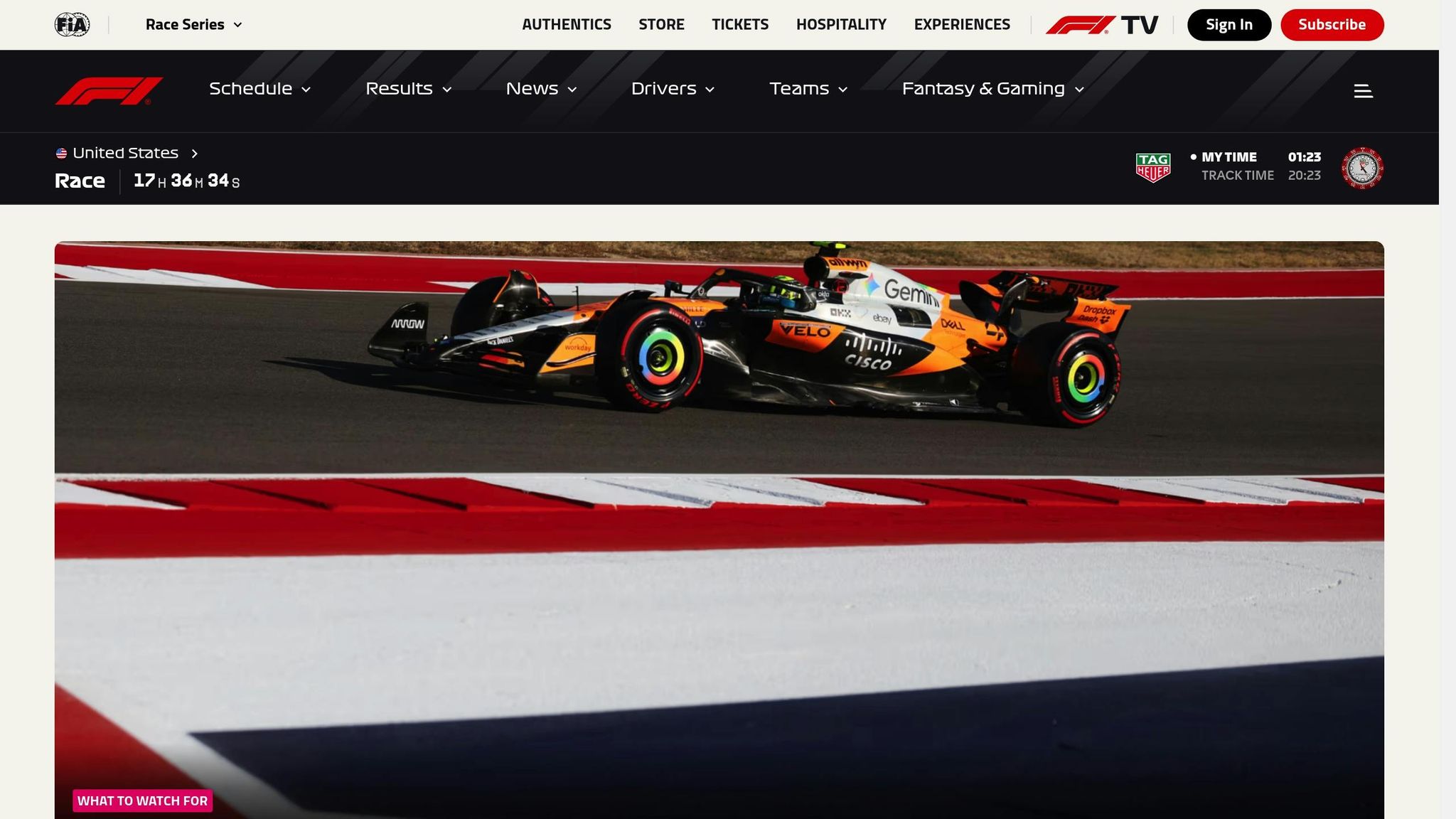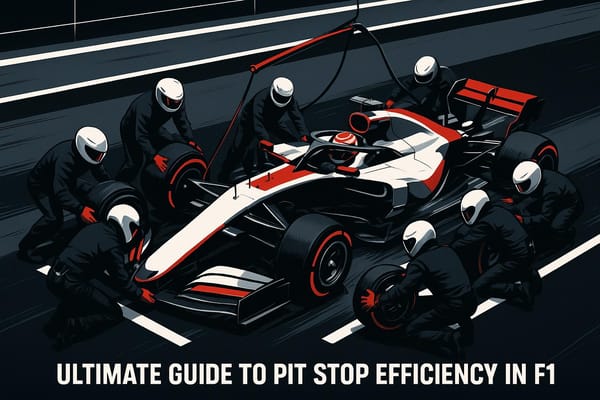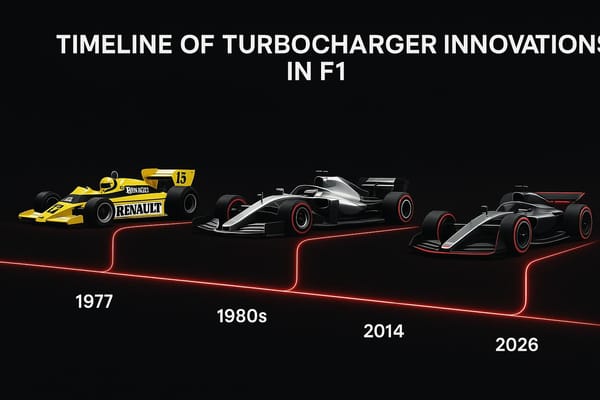5 Ways Teams Use Historical Data in F1
Explore how Formula 1 teams leverage historical data to enhance performance, strategize races, and outsmart competitors for success.

Formula 1 teams rely on historical data to improve car performance, refine strategies, and gain a competitive edge. With 70+ years of racing history and advanced technologies like machine learning, teams analyze vast datasets to make informed decisions. Here’s how they use historical data:
- Compare Car Performance: Teams evaluate telemetry, lap times, and race results across seasons to identify strengths and weaknesses in car design.
- Develop Race Strategies: Past results help teams plan tire usage, fuel loads, and pit stops tailored to specific tracks and conditions.
- Study Competitors: Teams analyze rivals' telemetry, pit strategies, and decision-making to exploit weaknesses and anticipate moves.
- Guide Car Upgrades: Historical data informs aerodynamic tweaks, engine improvements, and other upgrades for better performance.
- Run Simulations: Teams use decades of data to simulate races, predict outcomes, and adjust strategies in real time.
The INCREDIBLE Evolution of Formula 1 Lap Times

1. Comparing Car Performance Between Seasons
Formula 1 teams rely heavily on historical performance data to evaluate how their cars have evolved over time. By analyzing telemetry, lap times, and race results across different seasons, engineers can identify areas where their designs have excelled or fallen short. This year-over-year evaluation is a cornerstone of making informed development decisions.
The process starts with examining key metrics like lap times, sector splits, top speeds, cornering speeds, tire wear, and fuel efficiency. By comparing these figures at the same circuits across seasons, teams can determine whether changes like aerodynamic tweaks, engine upgrades, or suspension adjustments have delivered the desired results. These comparisons often reveal specific areas for improvement, as later team analyses demonstrate.
Take Mercedes, for example. Their analysis of telemetry data highlighted time losses in slow corners, revealing weaknesses in mechanical grip and low-speed downforce. Armed with this insight, they made targeted upgrades that improved lap times on circuits with multiple slow corners.
This kind of analysis benefits from the sport's rich history. With 70 years of race data at their fingertips, engineers can detect patterns that might otherwise remain hidden. For instance, Red Bull Racing’s evaluation of their RB18 in 2022 revealed that a new floor design shaved 0.3 seconds off average lap times but increased tire wear - a tradeoff that informed their future designs.
To make these comparisons even more precise, teams account for external factors like weather, track resurfacing, and regulation changes. Statistical models and simulations help normalize the data, ensuring that performance differences reflect actual car development rather than outside influences. By isolating these variables, teams can focus on genuine improvements.
Advanced tools like Computational Fluid Dynamics (CFD) and machine learning further enhance these analyses. These technologies allow engineers to simulate aerodynamic performance across seasons, helping them validate their findings by comparing predicted lap times with real-world benchmarks before committing to costly design changes.
McLaren Racing’s turnaround from a challenging start in early 2023 to consistent success by October 2025 underscores the value of historical data analysis. By identifying weaknesses in their car's performance and implementing targeted engineering solutions, the team achieved a remarkable recovery.
Teams also use publicly available data, such as qualifying times and race pace, to benchmark against competitors. Comparing their own performance trends with those of rival teams helps engineers set realistic goals and prioritize upgrades that close performance gaps.
The effort pays off. For instance, Red Bull’s refinement of the RB19 in 2023, based on prior data reviews, led to an additional 0.2 seconds per lap improvement. They also resolved DRS reliability issues that had been flagged in earlier analyses, showcasing how meticulous data evaluation can drive measurable gains.
2. Building Race Strategies from Past Results
Formula 1 teams transform historical race data into detailed strategies by examining how each track behaves under different conditions. This analysis goes beyond simply looking at lap times - it dives into tire wear, fuel usage, and weather patterns to craft a race plan tailored to each circuit.
Tire wear is a key focus. Teams study how different compounds perform under various conditions, paying attention to degradation rates. For example, at high-temperature tracks like Bahrain, historical data often shows that soft tires wear out quickly. This prompts teams to opt for harder compounds or plan shorter stints to maintain a strong pace without compromising performance.
Fuel consumption is another critical aspect. By reviewing past races, teams calculate the ideal fuel loads to balance speed with the penalty of carrying extra weight. This calibration also considers unexpected factors like safety car periods or race extensions, ensuring cars aren’t unnecessarily slowed by even a fraction of a second per lap.
Weather data adds yet another layer to strategy development. Teams track historical trends in temperature, humidity, and rainfall for each Grand Prix. At unpredictable circuits like Spa-Francorchamps, where conditions can change rapidly, this data helps teams prepare for multiple scenarios, from dry to wet setups, and fine-tune pit stop timing accordingly.
Pit stops themselves are meticulously planned using past data. Teams identify the best windows to stop, factoring in traffic, overtaking opportunities, and safety car likelihood. At circuits like Monaco, where overtaking is almost impossible, historical insights help pinpoint the exact laps that minimize time loss while avoiding traffic jams.
Simulations play a massive role in refining strategies. Teams run millions of race scenarios, incorporating variables like competitor tactics, weather forecasts, and tire degradation patterns. These simulations allow teams to test different approaches and develop contingency plans for unexpected situations.
Real-time telemetry combined with historical benchmarks further enhances adaptability. For instance, if live data shows tire wear exceeding historical norms, teams can quickly shift from a one-stop to a two-stop strategy to stay competitive.
Machine learning also comes into play, uncovering patterns that might escape human analysts. These systems can identify subtle connections, such as how ambient temperature influences fuel efficiency or how track evolution impacts tire grip, giving teams valuable insights to fine-tune their approach.
Teams don’t just analyze their own data - they also study competitors' past strategies at each circuit. By identifying patterns in rivals' decision-making and spotting potential weaknesses, teams can anticipate moves and position themselves for an advantage during the race.
3. Analyzing Competitor Performance and Tactics
Formula 1 teams leave no stone unturned when it comes to understanding their rivals. They meticulously compile detailed profiles of competitors by analyzing race data collected over several seasons. This goes far beyond simply looking at lap times - teams dive into telemetry data, pit stop trends, tire strategies, and in-race decision-making to uncover both strengths and exploitable weaknesses.
F1 cars produce an overwhelming amount of telemetry data - millions of data points every second. This treasure trove allows teams to study how competitors manage critical factors like tire wear, fuel efficiency, and car setups under varying track and weather conditions. With this data in hand, teams can break down lap times and pit strategies with incredible precision.
Lap times and sector splits are key components of this analysis. By examining where rivals gain or lose time - whether it’s through cornering, straight-line speed, or braking - teams can identify who poses the biggest threat on specific circuits or in particular conditions. This granular level of detail helps strategists fine-tune their approach for each race.
Pit stop data is another goldmine. Teams review historical records to uncover patterns like when competitors tend to pit, how long their stops usually take, and which tire compounds they prefer in different scenarios. For example, if data shows a rival struggles with tire degradation after a certain number of laps, teams can plan an aggressive undercut strategy to exploit that weakness.
Machine learning has revolutionized this process. By analyzing over 70 years of race data, these models can predict competitor behavior with impressive accuracy. Teams use this technology to spot subtle patterns, such as a rival’s tendency to gamble during safety car periods or their preferred pit windows. Monte Carlo simulations, running millions of hypothetical scenarios, allow teams to test strategies against likely competitor moves. For instance, by inputting data on how a team typically reacts to safety cars, strategists can anticipate and counter their decisions in real time.
A perfect example of this was the 2019 Hungarian Grand Prix. Mercedes used insights from Red Bull’s previous tire degradation patterns to switch Lewis Hamilton to a two-stop strategy. This decision allowed Hamilton to catch and overtake Max Verstappen in the final laps - a move rooted in meticulous competitor analysis.
Beyond the numbers, teams also analyze how rivals make decisions under pressure. They assess risk tolerance, adaptability when plans go awry, and how competitors handle high-stakes situations. This psychological profiling helps teams predict not just what their rivals can do, but what they’re likely to do when the heat is on.
Real-time monitoring during races adds another layer of insight. If a competitor deviates from their usual patterns - like making an unexpected early pit stop or struggling with tire temperatures - teams can adjust their strategy on the fly to seize the advantage. This combination of historical data and live analysis often makes the difference between winning and losing.
Advanced analytics platforms further enhance this process by presenting complex data through intuitive dashboards. These tools allow strategists to quickly interpret trends and make split-second decisions during the race. By turning raw data into actionable insights, teams gain a critical edge when it matters most.
4. Guiding Car Development and Upgrades
After thorough strategic and performance analyses, teams dive into historical data to refine car development and implement upgrades.
Each Formula 1 car generates an astonishing 1.1 million data points every second, collected from 300 sensors. This treasure trove of information, combined with over 70 years of race data, helps teams understand how different components perform under various conditions.
Take aerodynamic development, for instance. Historical data is used to pinpoint drag issues on high-speed circuits. Teams then prioritize redesigning elements like rear wings and floors, often relying on CFD (Computational Fluid Dynamics) simulations to fine-tune these components. But the focus doesn't stop at aerodynamics - it extends to every system in the car.
A great example comes from 2021, when Mercedes tapped into historical data and machine learning to enhance its aerodynamic package for the Spanish Grand Prix. The result? A 0.2-second per lap improvement. Similarly, Red Bull Racing used telemetry data from past races at Monaco to guide suspension upgrades, boosting cornering speed by 1.5%.
Engineers also rely on historical data to refine control algorithms, addressing issues like wheelspin, energy deployment, and gearbox performance. This data helps them identify where time is being lost. For example, if a team consistently struggles in slower corners, they might prioritize aerodynamic upgrades to increase downforce. On the other hand, repeated losses in straight-line speed could signal the need for power unit enhancements or drag reduction measures.
Machine learning further amplifies this process. By analyzing historical patterns, these models predict how upgrades will perform under different conditions. Simulations then provide insights that guide smarter, more effective decisions.
The integration of real-time and historical data creates a feedback loop that allows engineers to validate and adjust upgrades during practice sessions. If results don't align with expectations, they can quickly pivot and refine their approach using the latest data.
Ultimately, these data-driven upgrades often deliver performance gains measured in mere tenths or even hundredths of a second per lap. In a sport where championships can hinge on the tiniest margins, leveraging historical data to its fullest potential is nothing short of essential.
5. Creating Race Simulations and Predictions
After conducting thorough performance reviews and tactical assessments, Formula 1 teams take it a step further by using simulation models to predict race outcomes. These models blend decades of historical race data with live telemetry, factoring in variables like weather conditions, tire wear, fuel consumption, and the likelihood of safety car deployments based on past incidents at specific tracks.
Machine learning plays a big role here. Algorithms analyze data on tire performance, weather patterns, and car behavior to uncover critical trends. Historical lap times, pit stop durations, and weather records are fed into these systems to fine-tune predictions. This process isn’t just theoretical - it directly supports real-time decision-making during races.
With live telemetry streaming in at an astonishing 1.1 million data points per second, teams compare these updates with historical data to identify the best moments for pit stops and adjust strategies accordingly. When unexpected events like sudden rain or a safety car occur, teams quickly rerun simulations using updated data, allowing them to adapt their plans on the spot.
A great example of this was the 2020 Turkish Grand Prix. Teams used historical weather and tire data to simulate how a slippery track surface combined with rain would impact performance. Using past wet-weather stats, they opted for intermediate tires earlier than usual - a decision that turned out to be game-changing.
In 2021, AWS machine learning brought even more sophistication to the table. Teams simulated alternative strategies, including pit stop timings, to optimize in-race decisions. These simulations were also shared with fans, offering insights into the complex strategies unfolding during the race.
To ensure their models are reliable, teams validate them by comparing simulation results with past race outcomes and refining the parameters. Engineers also run scenario analyses, testing various race-day conditions and cross-referencing predictions with live data from practice sessions and qualifying rounds.
Predictive models also help teams prepare for rare or chaotic events. Simulations can model scenarios like multi-car crashes, sudden weather shifts, or red flag interruptions, enabling teams to create contingency plans and decision trees for quick, effective responses during the race.
Advanced statistical approaches, like Bayesian and rank-ordered logit models, add another layer of precision. By analyzing data from 160 races between 2014 and 2021, these methods rank performance and simulate potential outcomes.
Conclusion
Historical data has transformed Formula One, turning what was once a sport of pure intuition into a finely-tuned battle of precision and strategy, driven by decades of analytics and real-time telemetry. The five key methods we’ve discussed - comparing car performance, crafting race strategies, analyzing competitors, guiding development, and running simulations - highlight how teams now tap into over 70 years of racing data to gain an edge on the track.
The impact of this shift is clear on race day. Take Mercedes’ 2021 Silverstone strategy, for example. By using historical tire degradation data from previous races, they adjusted their pit stop timing, enabling Lewis Hamilton to clinch victory in the final laps. It’s a perfect example of how meticulous analysis of past performance under specific conditions can directly influence the outcome of a race.
What’s especially striking is how machine learning has been seamlessly integrated into traditional racing expertise. Teams now run up to 300 million race simulations, accounting for everything from weather changes to safety car probabilities. These simulations, powered by historical data, allow for real-time strategic decisions that can make or break championship campaigns.
Cloud computing partnerships, such as those between AWS and F1, have further revolutionized the sport. These collaborations enable teams to compare performances across different eras while stripping away variables like car performance to objectively evaluate driver talent - something that was once unimaginable without robust historical datasets.
Looking ahead, the role of data in Formula One will only grow. Advanced AI and improved data collection techniques will reward teams that successfully blend decades of racing knowledge with predictive analytics. Those who embrace this evolution will continue to dominate, while others risk falling behind in this increasingly data-driven competition.
These advancements are redefining the F1 landscape. For fans eager to dive deeper into the technical and strategic aspects of the sport, F1 Briefing offers detailed analysis and expert commentary, shining a light on how data is reshaping the world of Formula One and driving modern racing success.
FAQs
How do Formula 1 teams use historical data to prepare for unexpected race conditions like sudden weather changes?
Formula 1 teams tap into historical data to navigate the unpredictable nature of race conditions, like sudden weather changes. By studying past race information - such as weather patterns, tire performance, and car behavior under similar circumstances - they can make smarter, quicker decisions when it matters most.
Take tire strategy, for instance. Historical data allows teams to estimate how different tire compounds will hold up on a wet or drying track, helping them fine-tune pit stop strategies on the fly. On top of that, combining weather forecasts with past trends gives teams a clearer picture of potential shifts in conditions, keeping them prepared and competitive no matter what surprises the race throws their way.
How do Formula 1 teams use machine learning to analyze competitors' strategies and gain an edge?
Formula 1 teams use machine learning to sift through massive amounts of historical and live data, enabling them to anticipate their competitors' strategies. By examining trends in tire wear, pit stop patterns, and lap times, these models can predict what moves rival teams might make during a race.
This ability to forecast gives teams a clear edge, allowing them to tweak their strategies on the fly. For instance, they can time pit stops more effectively or adjust their race pace to counter an opponent's tactics. Beyond race-day decisions, machine learning also plays a key role in shaping long-term strategies by uncovering patterns and pinpointing vulnerabilities in competitors' approaches over several seasons.
How do Formula 1 teams turn historical data into better on-track performance?
Formula 1 teams rely heavily on historical data to fine-tune their race strategies, adjust car setups, and predict race conditions. By digging into past performance metrics - like tire degradation, fuel usage, and weather trends - they're able to make smarter decisions that can significantly influence their results on race day.
To turn these insights into actual on-track advantages, teams use advanced simulation software to model different scenarios. They then test these strategies during practice sessions, giving them a chance to confirm their data-driven choices and tweak them in real time for peak performance when it matters most.




